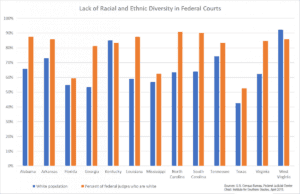Trump Is Erasing Racial Diversity from the South’s Federal Courts
Billy Corriher, Facing South, April 11, 2018
This week the White House announced 19 new judicial nominees, and — like President Trump’s previous nominees — the overwhelming majority are white. Of the over 100 attorneys he’s nominated to federal judgeships to date, around 92 percent are white, with only a handful of African Americans and Latinos. Trump’s record on judicial diversity is the worst since President Reagan.
Trump’s regression on judicial diversity could take decades to reverse. He is nominating judges at a much faster pace than President Obama, and — despite the glaring lack of diversity — the Senate is rapidly confirming them to seats it refused to fill in 2016 and 2017. Trump’s nominees are also relatively young, which means these white judges will preside over an increasingly diverse population for decades to come.
This is especially true in the fast-changing South, where federal courts have historically played a critical role in protecting civil rights. While Republican senators in North Carolina and other Southern states blocked some of Obama’s non-white judicial nominees, they have supported Trump’s white nominees, including a North Carolina lawyer with ties to white supremacists. In Tennessee, Obama’s black nominee was blocked by Senate leaders and then replaced with a white Trump pick.
Until this week, Trump had put forth only one African-American and one Latino judicial nominee. {snip}
All three of Trump’s pending nominees to the 5th U.S. Circuit Court of Appeals are white, including one to replace the court’s only Latino judge. The 5th Circuit rules on cases out of Louisiana, Mississippi, and Texas, a region in which white people constitute a minority of the population.
{snip}
“President Richard Nixon began appointing conservatives to the bench as part of the Republican ‘Southern strategy’ in the 1960s of appealing to whites by slowing racial integration,” Bass wrote in The Nation.
{snip}
An article in the Berkeley La Raza Law Journal noted that President Clinton made great strides in diversifying the courts, and President George W. Bush’s nominees were nearly as diverse. President Obama shattered records for judicial diversity, appointing well over 100 people of color to the federal courts, though some of his nominees were blocked by Southern senators.
{snip}
On the same day, Trump offered a black nominee to serve on the Middle District of Alabama — but he later transferred the nomination to the Southern District. This required the administration’s only black nominee, Judge Terry Moorer, to move out of the district that included the state capital and thus would be more likely to hear redistricting cases or those involving political corruption.
Trump then nominated a young, inexperienced lawyer named Brett Talley to the Middle District slot. Talley withdrew after questions about his qualifications and failure to disclose statements posted on the Internet that, among other things, defended an early Ku Klux Klan leader.
White supremacy on the bench?
The Eastern District of North Carolina is home to a quarter of the state’s black population, but it has never had a black federal judge. {snip}
Near the end of his tenure, President George W. Bush nominated Thomas Farr, a Republican lawyer with close ties to Helms, to an empty seat on the Eastern District. Farr’s nomination stalled, and President Obama then put forth two different nominees — both black women, one of whom was recommended by Sen. Richard Burr. The Senate refused to move forward on either nominee, leaving the seat vacant for a decade.
Trump re-nominated Farr last year, but his nomination has been slowed by concerns about his ties to white supremacy. Farr’s long-time law partner, Tom Ellis, was formerly affiliated with the racist Pioneer Fund, which argued that white people were genetically superior. Farr honored Ellis in a 2007 speech. Farr has also came under fire for his role in a voter intimidation scheme while a lawyer for Helms’ 1992 campaign, with senators demanding to know whether he concealed his involvement.
Farr was also involved in the North Carolina legislature’s drafting of its discriminatory 2013 voting law, which instituted a voter ID requirement and other rules to make it harder to vote. {snip}
{snip}
Trump has nominated a white lawyer to replace the sole Latino judge on the 5th Circuit, though he recently announced a few Latino nominees to judgeships in Texas. Latinos, who account for 39 percent of Texas’ population, are also drastically underrepresented in the state legislature. By the end of Trump’s first term, a majority of Texas’ voting eligible population will be people of color, but the federal courts that preside over the state could be less ethnically diverse.
{snip}
Trump’s nominations would not only make the 5th and 11th Circuits less diverse but also more ideologically extreme. For example, Trump’s white nominees from Texas have included judges with radical ideologies and lawyers with a history of fighting against equal rights for LGBT people and women. {snip}
{snip}
The implications of this trend will be felt across the country. Even before Trump, the 5th Circuit had a record of blocking important federal regulations. Near the end of President Obama’s tenure, for example, the 5th Circuit upheld orders from Texas judges that imposed nationwide injunctions on the DACA program and new rules on overtime pay.
[Click on the image to enlarge it.]
















